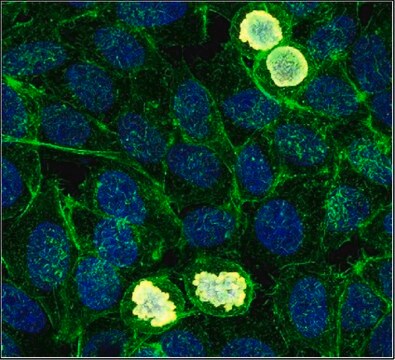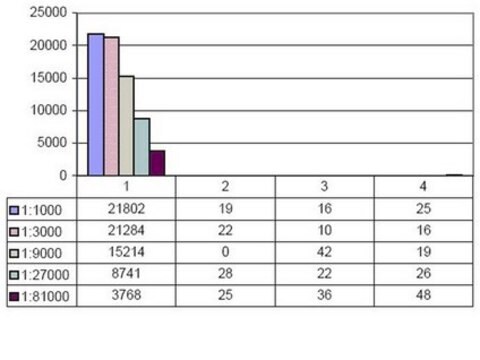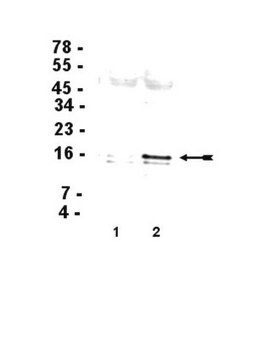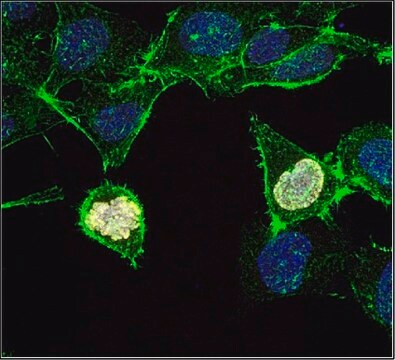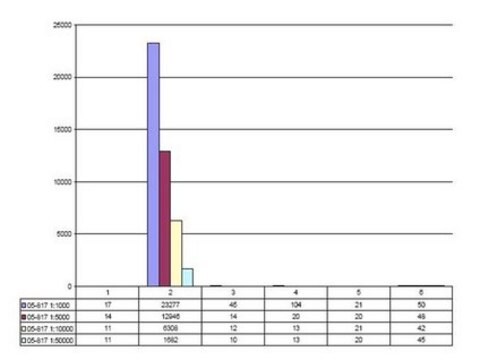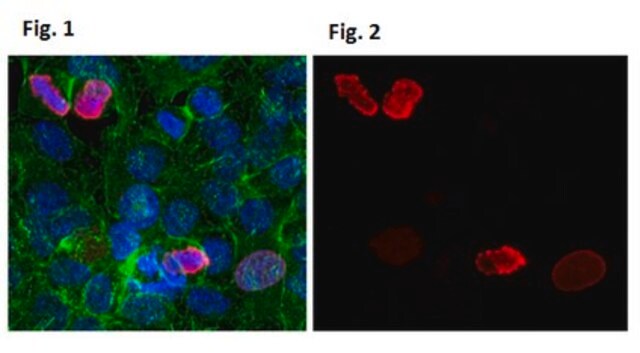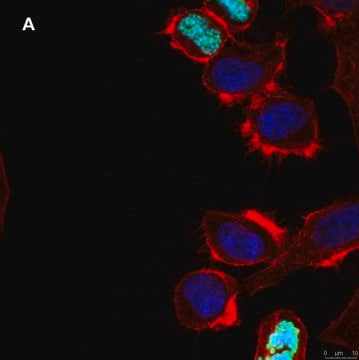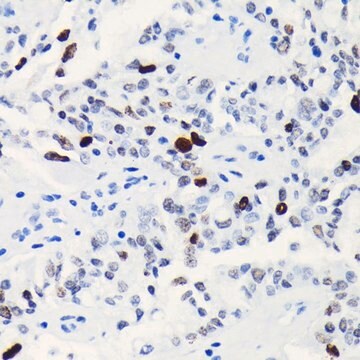推荐产品
生物源
rabbit
品質等級
共軛
ALEXA FLUOR™ 488
抗體表格
purified antibody
抗體產品種類
primary antibodies
無性繁殖
polyclonal
物種活性
human, mouse
技術
immunocytochemistry: suitable
NCBI登錄號
UniProt登錄號
運輸包裝
wet ice
目標翻譯後修改
phosphorylation (pSer10)
基因資訊
human ... HIST1H3F(8968)
一般說明
组蛋白H3是参与真核细胞染色质结构的五种主要组蛋白之一。H3具有一个主要的球状结构域和一个长N末端的尾巴,其与核糖体核小体′串珠′结构体的结构有关。组蛋白H3的N末端尾部从球状核小体核心突起,其可能发生几种不同类型的表观遗传修饰,从而影响细胞过程。这些修饰包括甲基或乙酰基与赖氨酸和精氨酸的共价连接,以及丝氨酸或苏氨酸的磷酸化。
免疫原
对应于磷酸化组蛋白H3(Ser10)的线性肽。
應用
免疫细胞化学分析:代表性批次的1:50稀释液可在NIH/3T3细胞中检测到磷酸化组蛋白H3 (Ser10)。
蛋白质印迹分析:代表性批次的1:1,000稀释液可在HeLa细胞中检测到组蛋白H3 (Ser10)。
蛋白质印迹分析:代表性批次的1:1,000稀释液可在HeLa细胞中检测到组蛋白H3 (Ser10)。
抗磷酸化H3 (Ser10)抗体-Alexa Fluor™ 488偶联物是一种纯化的兔多克隆抗体,可检测丝氨酸 10 磷酸化的组蛋白 H3。该抗体采用Alexa Fluor 488标记,并通过IC验证。该抗体的无标记版本得到广泛引用,并通过ICC、I IP & WB验证。
研究子类别
表位标签
表位标签
研究类别
表位标签 & 一般用途
表位标签 & 一般用途
品質
通过免疫细胞化学在HeLa细胞中进行评估。
免疫细胞化学分析:用该抗体的1:50稀释液可在HeLa细胞中检测磷酸化组蛋白H3 (Ser10)。
Alexa Fluor™是Life Technologies的注册商标。
免疫细胞化学分析:用该抗体的1:50稀释液可在HeLa细胞中检测磷酸化组蛋白H3 (Ser10)。
Alexa Fluor™是Life Technologies的注册商标。
標靶描述
可观察到约17 kDa的条带
外觀
纯化的兔抗体偶联物,溶于含有PBS、15 mg BSA和0.1%叠氮化钠的缓冲液中。
纯化蛋白A
儲存和穩定性
自收到之日起,在2-8°C条件下可稳定保存1年。
其他說明
浓度:请参考批次特异性浓缩物的检验报告。
法律資訊
ALEXA FLUOR is a trademark of Life Technologies
免責聲明
除非我们的产品目录或产品附带的其他公司文档另有说明,否则我们的产品仅供研究使用,不得用于任何其他目的,包括但不限于未经授权的商业用途、体外诊断用途、离体或体内治疗用途或任何类型的消费或应用于人类或动物。
未找到合适的产品?
试试我们的产品选型工具.
儲存類別代碼
12 - Non Combustible Liquids
水污染物質分類(WGK)
WGK 2
閃點(°F)
Not applicable
閃點(°C)
Not applicable
Zoe L Grant et al.
The Journal of clinical investigation, 130(8), 4235-4251 (2020-05-20)
Aberrant, neovascular retinal blood vessel growth is a vision-threatening complication in ischemic retinal diseases. It is driven by retinal hypoxia frequently caused by capillary nonperfusion and endothelial cell (EC) loss. We investigated the role of EC apoptosis in this process
Matheus H Dias et al.
Molecular oncology, 13(2), 290-306 (2018-11-14)
In malignant transformation, cellular stress-response pathways are dynamically mobilized to counterbalance oncogenic activity, keeping cancer cells viable. Therapeutic disruption of this vulnerable homeostasis might change the outcome of many human cancers, particularly those for which no effective therapy is available.
Haley Jeanette et al.
Glia, 69(4), 1061-1074 (2020-12-19)
YAP and TAZ are effectors of the Hippo pathway that controls multicellular development by integrating chemical and mechanical signals. Peripheral nervous system development depends on the Hippo pathway. We previously showed that loss of YAP and TAZ impairs the development
我们的科学家团队拥有各种研究领域经验,包括生命科学、材料科学、化学合成、色谱、分析及许多其他领域.
联系技术服务部门
